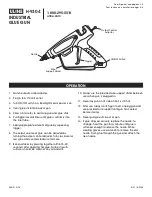
Page 10
For technical questions, please call 1‑800‑444‑3353.
SKU 68023
2. Attach an air hose to the compressor’s
air outlet. Connect the air hose to the air
inlet of the tool. Other components, such
as a coupler plug and quick coupler, will
make operation more efficient, but are
not required.
WARNING! TO PREVENT SERIOUS
INJURY FROM ACCIDENTAL
OPERATION:
Do not install a quick coupler on the
tool.
A coupler contains an air valve that
will allow the air tool to retain pressure
and operate accidentally after the air
supply is disconnected.
Note:
Air flow, and therefore tool
performance, can be hindered by
undersized air supply components.
3. The air hose must be long enough to
reach the work area with enough extra
length to allow free movement while
working.
4. Release the Trigger.
5. Close the in-line safety valve between
the compressor and the tool.
6. Turn on the air compressor according to
the manufacturer’s directions and allow it
to build up pressure until it cycles off.
7. Adjust the air compressor’s output
regulator so that the air output is enough
to properly power the tool, but the output
will not exceed the tool’s maximum
air pressure at any time. Adjust the
pressure gradually, while checking the
air output gauge to set the right pressure
range.
8. The air pressure setting must not exceed
job site regulations/restrictions. The air
pressure setting must not exceed 90 PSI
when being used with work pieces that
have a thickness of less than 1-3/4”.
9. Inspect the air connections for leaks.
Repair any leaks found.
10. If the tool will not be used at this time,
turn off and detach the air supply, safely
discharge any residual air pressure, and
release the trigger to prevent accidental
operation.
Note:
Residual air pressure should not be
present after the tool is disconnected
from the air supply. However, it is a
good safety measure to attempt to
discharge the tool in a safe fashion after
disconnecting to ensure that the tool is
disconnected and unpowered.






























